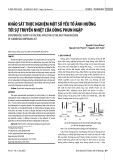
A new method for enhancing the performance
of red mud as a hydrogenation catalyst
Jorge A
Âlvarez, Salvador Ordo
Ân
Äez, Roberto Rosal, Herminio Sastre, Fernando V. Dõ
Âez
*
Department of Chemical and Environmental Engineering, University of Oviedo, 33071-Oviedo, Spain
Received 22 April 1998; received in revised form 30 October 1998; accepted 5 November 1998
Abstract
A new method is presented for improving the performance of red mud as a hydrogenation catalyst (a residue from the
production of alumina by the Bayer process that contains iron oxides), based on the method developed by K.C. Pratt and V.
Christoverson, Fuel 61 (1982) 460. The activation method consists essentially in dissolving red mud in a mixture of aqueous
hydrochloric and phosphoric acids, boiling the resulting solution, adding aqueous ammonia until pH8, and ®ltering,
washing, drying and calcining the resulting precipitate. The catalyst thus obtained is characterised, and after sulphidation,
tested (activity and life) for the hydrogenation of a light fraction of an anthracene oil. The catalytic performance is compared
with that of sulphided untreated red mud and sulphided red mud activated by the method of Pratt and Christoverson. This
activation method has proved to be more effective in improving the performance of red mud as a hydrogenation catalyst than
the method of Pratt and Christoverson, since the activated catalyst presents a slightly higher level of activity and a markedly
extended active life. #1999 Elsevier Science B.V. All rights reserved.
Keywords: Red mud; Anthracene oil; Catalyst deactivation; Catalytic hydrogenation; Scanning electron microscopy; X-ray
diffraction; Phosphorus promotional effect
1. Introduction
Red mud (RM) is a by-product in the manufacture
of alumina by Bayer process that contains mainly
oxides of iron, aluminium, titanium, silicon, calcium
and sodium. Sulphided red mud is active as a hydro-
genation catalyst, due to its iron sulphide content, and
has been used for the hydrogenation of organic com-
pounds [1,2], and the liquefaction of coal [2±4] and
biomass [5].
Catalytic hydrogenation of anthracene oil yields a
solvent with high hydrogen-donor capacity, due to its
content in hydroaromatic compounds such as dihy-
droanthracene, dihydrophenanthrene and tetrahydro-
¯uoranthene. Hydrogenated anthracene oil can be
used in processes in which transferable hydrogen
plays an important role, such as coal liquefaction
[8,11], oil-coal coprocessing [10,14], and coke pro-
duction by carbonisation of low-rank coals with pitch-
like materials [9].
In previous works, sulphided red mud (SRM) was
tested as a catalyst for the hydrogenation of anthracene
oil (a fraction obtained by distillation of coal tar,
containing two- to four-ring condensed aromatic
Applied Catalysis A: General 180 (1999) 399±409
*Corresponding author. Tel.: +34-98510-3508; fax: +34-98510-
3434; e-mail: fds@sauron.quimica.uniovi.es
0926-860X/99/$ ± see front matter #1999 Elsevier Science B.V. All rights reserved.
PII: S0926-860X(98)00373-1

hydrocarbons) [6], and its deactivation for this reac-
tion was studied [7]. The studies of the evolution with
time of the red mud activity were carried out at
constant temperature (623 K), pressure (10 MPa)
and ¯ow rates (hydrogen 410
ÿ6
Nm
3
/s, liquid feed
0.6 ml/min at room conditions). Catalyst samples
were collected after different reaction times and char-
acterised by BET nitrogen adsorption, scanning elec-
tron microscopy (SEM), and SEM-EDX. It was found
that sulphided red mud lost its catalytic activity after
40 h reaction time. The loss of catalytic activity of the
sulphided red mud was explained by a combination of
the loss of BET surface area (45% lost in the 40 h
period), and the loss of super®cial iron content, mea-
sured by EDX maps (74% loss in the 40 h period).
Several methods have been proposed for enhancing
red mud catalytic activity. Pratt and Christoverson [1]
proposed a dissolution±precipitation method, which
decreases the Ca and Na red mud content, and
increases its surface area. Red mud modi®ed by the
method of Pratt and Christoverson will be referred to
in this work as ``activated red mud'', ARM. Sulphided
activated red mud (SARM) was tested as a catalyst for
the hydrogenation of anthracene oil [12,15], and was
found to be both more active than untreated sulphided
red mud for the hydrogenation of acenaphthene,
anthracene, phenanthrene, ¯uoranthene and pyrene,
as well as presenting an extended active life (approx.
53 h).
In the present work, a new activation method of red
mud, based on the method proposed by Pratt and
Christoverson, is presented. The new proposed
method allows the addition of phosphorous to the
catalyst. Phosphorous has been shown to be a very
effective promoter for the non carbon-supported sul-
phide catalysts. Phosphorous has two different promo-
tional effects: it increases the stability of inorganic
supports [17], and it improves the dispersion of the
active phase [20±23]. However, phosphorus can also
be a strong catalyst poison, since it can react with
hydrogen yielding phosphine, that chemisorbs
strongly on the active sites. This effect is important
in carbon-supported catalysts, but is not important in
alumina supported catalysts [22,28], since the strong
phosphorous±metal oxide interaction avoids the
reduction of phosphorous. Another promotional effect
of phosphorous reported in the literature is its ability to
minimise the poisoning caused by metals present in
coal and oil fractions (i.e. vanadium) [25]. Although
the promotional effect of phosphorous on the activity
of sulphided catalysts has been extensively studied
[21,28], to our knowledge the effect of phosphorous
on catalyst life has not been documented.
Red mud samples activated by the new method were
characterised by BET nitrogen adsorption, X-ray dif-
fraction, scanning electron microscopy (SEM), and
SEM-EDX, and after sulphidation, tested as catalysts
(activity and life) for the hydrogenation of a light
fraction of an anthracene oil. Their catalytic perfor-
mance is compared with that of sulphided untreated
red mud and sulphided red mud activated by the
method of Pratt and Christoverson.
2. Experimental
2.1. Materials
The red mud used in this work was supplied by the
San Cipria
Ân (Lugo, Spain) plant of the Spanish alu-
minium company Inespal. Its composition, deter-
mined by atomic absorption spectrometry and
volumetric methods after acid dissolution and alkaline
fusion (details of the analytical method can be found
in [12,13]), is given in Table 1.
Reaction studies were carried out by hydrogenating
a light fraction of anthracene oil supplied by Nalon-
Chem (Asturias, Spain), the composition of which is
given in Table 2. The most important compounds are
phenanthrene, ¯uoranthene, pyrene, acenaphthene,
¯uorene and anthracene. Gaseous reactants were
hydrogen N-50, and a mixture of 10.7% hydrogen
sulphide and 89.3% hydrogen (vol%) for sulphiding
the catalysts.
2.2. Red mud activation
The method of Pratt and Christoverson for enhan-
cing the catalytic activity of red mud consists of
dissolving the red mud in aqueous hydrochloric acid,
boiling the resulting solution for 2 h, and producing a
precipitate by adding aqueous ammonia until pH8.
The precipitate is then ®ltered, washed with distilled
water, dried at 383 K, and calcined in air at 773 K for
2 h [1,15]. This method decreases the content of
400 J. A
Âlvarez et al. / Applied Catalysis A: General 180 (1999) 399±409

calcium and sodium in the catalyst (Table 1), and
increases its surface area (sodium is known to enhance
sintering [16]) (Table 3). The activation method pre-
sented in this work consists of dissolving the red mud
in a mixture of aqueous hydrochloric acid and ortho-
phosphoric acid (H
3
PO
4
). The subsequent treatments
are the same as that in the method of Pratt and
Christoverson: precipitation with ammonia, ®ltering,
washing, drying and calcining. Red mud activated by
this method (phosphorous-activated red mud, PARM)
contains different amounts of phosphorous, depending
on the proportion of phosphoric acid in the dissolving
solution.
2.3. Catalyst characterisation
The catalyst pore structure and surface area was
measured by nitrogen adsorption with a Micromeritics
Asap 2000 apparatus.
Catalyst morphology was studied by SEM in a JSM-
6100 apparatus. The SEM apparatus is equipped with
a Link X-ray microanalyser that provides a quantita-
tive chemical analysis of a catalyst surface layer to a
depth of about 1 micron, and supplies information on
the super®cial distribution of certain elements, provid-
ing maps in which the brightness of every pixel
depends on the concentration of this element. Catalyst
samples must be gold-coated for morphological exam-
ination, and polished and carbon-coated for EDX
studies.
X-ray diffraction studies were carried out using
Siemens D 5000 and Philips PW1729/1710 dust dif-
fractometers, both provided with monochromator and
sparkling detectors.
Table 1
Bulk and EDX composition of red mud samples (wt %)
Element RM ARM PARM-1 PARM-2
Bulk EDX Bulk EDX Bulk EDX Bulk EDX
Fe 19.7 21.7 25.1 28.9 23.6 27.5 23.0 26.8
Ti 13.0 11.9 16.1 12.8 14.5 11.6 14.1 11.5
Al 7.9 7.4 9.0 7.9 8.4 9.3 7.9 8.2
Na 3.7 3.0 0.1 0.4 0.0 0.0 0.0 0.0
Ca 5.1 4.9 0.9 4.1 2.0 3.9 2.1 4.1
Si 4.7 3.6 4.9 2.7 4.1 3.6 3.8 3.3
P 0.1 0.7 0.2 0.7 3.9 3.1 7.6 6.9
Table 2
Composition of anthracene oil (wt%)
Naphthalene 4.0
Acenaphthene 5.9
Dibenzofuran 3.1
Fluorene 4.9
9,10-Dihydroanthracene 0.8
Phenanthrene 18.2
Anthracene 4.4
Carbazole 2.9
Fluoranthene 10.2
Pyrene 6.2
2-Methylnaphthalene 1.0
Dibenzothiophen 1.2
Methylanthracene 1.1
Methylphenanthrene 1.2
Methylpyrene 1.5
Chrysene 1.7
Triphenilene 1.8
Table 3
Textural characteristics of different red mud samples, obtained by nitrogen adsorption
RM SRM ARM SARM PARM-1 SPARM-1 PARM-2 SPARM-2
BET surface (m
2
/g) 24.3 29.5 82.4 85.4 80.4 82.0 77.1 79.6
BJH desorption pore volume (cm
3
/g) 0.086 0.090 0.227 0.170 0.198 0.188 0.181 0.174
BET average pore diameter (nm) 12.1 10.5 9.8 8.6 8.8 10.6 8.4 9.7
J. A
Âlvarez et al. / Applied Catalysis A: General 180 (1999) 399±409 401

2.4. Reaction studies
The reactor used for the hydrogenation experiments
was a cylindrical stainless steel continuous packed bed
reactor with 9 mm internal diameter and 45 cm long.
Two grams of catalyst was placed in the central section
of the reactor, the upper and lower sections being ®lled
with low-area inert alumina. The catalysts were sul-
phided in situ before use by passing a mixture of 10%
hydrogen sulphide in hydrogen at atmospheric pres-
sure, heated to 673 K, through the reactor for 4 h. The
reactor was operated as a continuous trickle bed
reactor, liquid and gas feeds ¯owing concurrently
downwards. The liquid feed consisted of 20 wt%
anthracene oil dissolved in toluene for easier handling,
containing 1 wt% carbon sulphide, added to maintain
the catalyst in the sulphided form. The gas feed
consisted of high pressure hydrogen. Reaction pro-
ducts were collected in a cylindrical receiver, and
liquid samples were withdrawn by emptying the
receiver at different time intervals. Hydrogenated
anthracene oil was analysed by gas chromatography
using a capillary fused silica column with apolar
stationary phase SE-30, and the peak assignment
was performed by gas chromatography±mass spectro-
metry. Reactions were carried out under the same
conditions as the experiments using SRM [7], and
SARM [15]: pressure 10 Mpa, temperature 623 K,
hydrogen ¯ow rate 410
ÿ6
Nm
3
/s, and liquid ¯ow
rate (at room conditions) 0.6 ml/min. Further details of
the experimental set up and procedure of the reaction
are given in [6].
3. Results and discussion
3.1. Catalysts characterisation
Several samples of PARM were produced, with
different phosphorous content. The composition of
two samples containing approx. 4% and 8% phosphor-
ous (which will be referred to here as PARM-1 and
PARM-2, respectively), are given in Table 1. Both
ARM and PARM samples show a similar decrease in
sodium content, while the calcium content is higher in
PARM samples than in ARM.
The results of textural characterisation by nitrogen
adsorption for the catalyst samples, unsulphided and
sulphided, are given in Table 3 and Fig. 1. The surface
area was calculated according to the Brunauer, Emmet
and Teller method, while the pore volume was calcu-
lated using the method of Barret, Joyner and Halenda
[16]. The average pore diameter was calculated as
4(pore volume)/(surface). The surface area and pore
volume of the phosphorous-containing samples,
although much higher than that of RM, are slightly
lower than that of ARM, the surface area decreasing as
the phosphorous content increases. Samples prepared
with higher phosphorous content than PARM-1 and
PARM-2 decreased the surface area (61.3 m
2
/g for the
sample with 15% phosphorous). This behaviour,
which is in agreement with results reported for other
sulphided catalysts [17], suggest a crystallographic
reordering, or pore blockage, precipitation of phos-
phate ions [20].
The following red mud constituents were identi®ed
by X-ray diffraction: rutile, TiO
2
; hematite, Fe
2
O
3
;
goethite and lepidocrocite, FeO(OH); iron hydroxide,
Fe(OH)
3
; halloysite, Al
2
Si
2
O
5
(OH)
4
; and bayerite,
Al(OH)
3
. The effect of the activation methods and
sulphidation on these constituents is shown in Fig. 2.
PARM-1 and ARM diffractograms are very similar.
Both activation methods eliminate all the aluminium
containing crystalline forms (bayerite and halloysite),
and the iron containing forms lepidocrocite and iron
hydroxide. Goethite decreases in ARM, while it dis-
appears completely in PARM-1. PARM-1 also shows a
new unidenti®ed peak, which probably is associated
with a complex phase of iron, phosphorous and alu-
minium. Ramselaar et al. [27] found similar phases in
phosphorous-promoted Fe
2
O
3
/g-Al
3
O
3
catalysts using
Mossbauer spectroscopy.
Fig. 1. Pore volume distributions of: RM (*); ARM (&); PARM-
1(*); PARM-2 (&).
402 J. A
Âlvarez et al. / Applied Catalysis A: General 180 (1999) 399±409

Sulphidation forms pyrrhotite (Fe
(1-x)
S), and
decreases the crystalline iron oxides and hydroxides
content. This effect is more pronounced for SPARM-1,
which exhibits a higher pyrrhotite content and a lower
hematite content than SARM. Pyrrhotite is a non-
stoichiometric sulphide, nominally Fe
7
S
8
, with a
regular NiAs structure. This structure has ``iron
vacancies'' (formed by its non-stoichiometric
character), that exhibit spatial order. Pyrrhotite is
thermodynamically stable at temperatures above
2008C, and is catalytically active in hydrogenation
reactions [24].
The high content in pyrrhotite in PARM is tenta-
tively explained considering that the addition of phos-
phoric acid increases the solubility of Fe (III) into the
aqueous solution during the RM activation. When
ammonia is added, smaller particles of iron (III)
hydroxide precipitate. These particles are more easily
sulphided. Mc Cormick et al. [29] stated that diffu-
sional effects play an important role in the sulphida-
tion of iron (II) oxides.
3.2. Reaction studies
Under the reaction condition speci®ed in Section 2,
the anthracene oil constituents that were hydrogenated
to a measurable degree when using SPARM-1 and
SPARM-2 as catalysts, were the same as when using
SRM and SARM. These compounds and their respec-
tive main reaction products are: anthracene, yielding
9,10-dihydroanthracene and small amounts of 1,2,3,4-
tetrahydroanthracene; phenanthrene, yielding 9,10-
dihydrophenanthrene; ¯uoranthene, yielding
1,2,3,10b-tetrahydro¯uoranthene; and pyrene, yield-
ing 4,5-dihydropyrene. The hydrogenation of these
compounds accounts for more than 75% of the total
hydrogen consumption, and no hydrogenation or
cracking products of the solvent (toluene) were
detected. The evolution of the conversions of the
aforementioned compounds with reaction time is
shown in Fig. 3 (SPARM-1) and Fig. 4 (SPARM-2).
Fig. 2. X-ray diffractograms for: (a) RM; (b) SRM; (c) ARM; (d)
SARM; (e) PARM-1; (f) SPARM-1.
Fig. 3. Conversions versus run time for SPARM-1: anthracene
(*); phenanthrene (&); fluoranthene (*); pyrene (&).
Fig. 4. Conversions versus run time for SPARM-2: anthracene
(*); phenanthrene (&); fluoranthene (*); pyrene (&).
J. A
Âlvarez et al. / Applied Catalysis A: General 180 (1999) 399±409 403




![Câu hỏi ôn tập Môi trường và phát triển [năm]](https://cdn.tailieu.vn/images/document/thumbnail/2025/20250710/kimphuong1001/135x160/2361752136158.jpg)
![Câu hỏi ôn tập Con người và môi trường: Tổng hợp [mới nhất/chuẩn nhất]](https://cdn.tailieu.vn/images/document/thumbnail/2025/20250704/kimphuong1001/135x160/8741751592841.jpg)
![Câu hỏi ôn tập môn Môi trường [chuẩn nhất]](https://cdn.tailieu.vn/images/document/thumbnail/2025/20250702/kimphuong555/135x160/62401751441591.jpg)
![Tài liệu tập huấn quản lý và bảo tồn đất ngập nước [mới nhất]](https://cdn.tailieu.vn/images/document/thumbnail/2025/20250627/vijiraiya/135x160/30351751010876.jpg)




![Quản Lý Rủi Ro Thiên Tai & Biến Đổi Khí Hậu: Tài Liệu Kỹ Thuật [Mới Nhất]](https://cdn.tailieu.vn/images/document/thumbnail/2025/20251225/tangtuy08/135x160/46811766713087.jpg)













